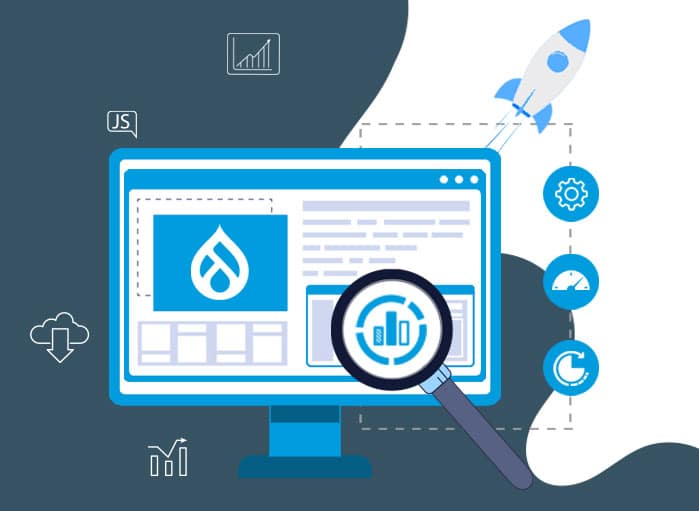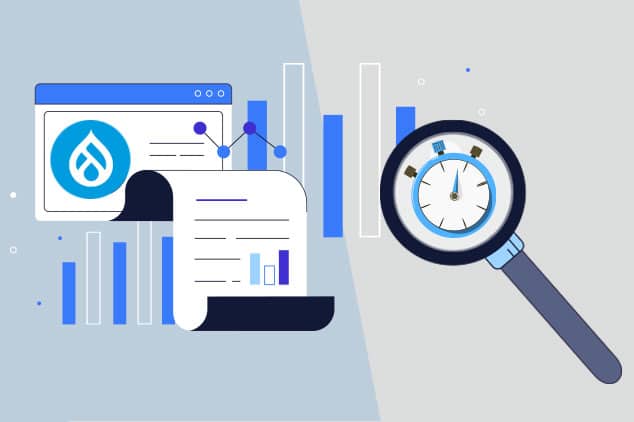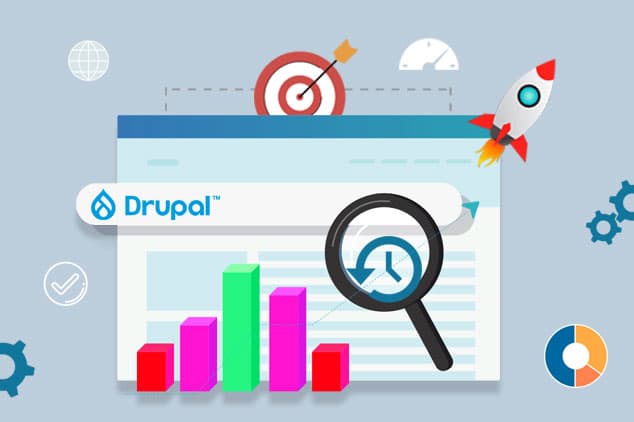
Drupal Performance Optimization Secrets to Follow in 2023
Tags: Drupal


Ever wondered why your Drupal site isn’t as fast as you’d like it to be? The answer lies in performance optimization. Now let’s see how this is going to work. Every time a visitor comes to your Drupal site, they want it to load fast. In the event your site takes too long to load, they will leave. To ensure your website loads fast, Drupal performance optimization is very helpful.
But here’s the catch. It’s not just about making your site faster for visitors. Search engines, like Google or Bing, reward fast websites with higher rankings. So, by focusing on Drupal website performance optimization, you’re hitting two birds with one stone
First, we’ll take you through the basics of Drupal performance. After that, you will be taken through the specifics of Drupal site performance optimization. As a part of the Drupal site performance optimization process, we’ll provide you with some tips and tricks to make your Drupal website perform very well. By the end of this blog post, you’ll have a clear idea of how to accelerate the speed and performance of your Drupal website.
Ready to jump in? Let’s boost that Drupal website speed together!
Prioritizing Performance for Drupal Websites

In 2023, the digital landscape is more competitive than ever. You’re likely falling behind if you’re not prioritizing your website’s speed and performance.
Let’s dive into why they are crucial, especially for Drupal enthusiasts.
The Importance of Website Performance in 2023
Drupal site performance optimization is the key to ensuring your site stays caught up. With more businesses moving online, Drupal website performance optimization has become the cornerstone of a successful online presence.
In today’s fast-paced world, website speed is of utmost importance. Users expect that websites should load in the blink of an eye. In fact, a study showed that a one-second delay in page load time can lead to a 7% conversion loss. (Source: Hobo)
Moreover, 53% of mobile users leave a site if it takes longer than three seconds to load. (Source: Think with Google) Now, imagine the potential loss it causes to your business! For Drupal website owners, this is even more pressing.
You must keep in mind that Drupal performance optimization isn’t just about speed, it’s about delivering a seamless user experience. In fact, Drupal website optimization isn’t just about keeping your visitors happy; rather, it’s about ensuring your website stands out in a crowded digital space.
Thus, neglecting Drupal site performance optimization can mean missing out on potential customers and revenue.
Why Drupal Performance Optimization Matters?

The digital world is more dynamic than ever. Without optimization of a Drupal site, staying ahead in the race is very difficult. Let’s explore why optimizing a Drupal site for improved performance is mandatory.
The Changing Digital Landscape and Rising User Expectations
The internet has grown leaps and bounds, and user expectations have skyrocketed with it. Now, more than ever, users demand websites to load fast across all devices.
Drupal performance optimization plays a pivotal role in meeting these demands. And as technology evolves, so does the need for optimized websites. With the influx of new devices, varying screen sizes, and innovative browsing methods, Drupal site performance optimization ensures that websites remain adaptable and user-friendly, irrespective of the device one is using.
Moreover, in a world where patience is thinning, a slow-loading site can turn away potential visitors in seconds. So, it’s clear that without Drupal website performance optimization, even the most content-rich sites risk becoming obsolete.
The Direct Correlation Between Website Performance and Business Success
Success in the digital realm is no longer just about having an online presence. It’s about delivering that presence efficiently and effectively. This is where Drupal performance optimization comes into the picture.
We have seen that faster websites lead to longer visitor durations, lower bounce rates, and higher conversions. So, it won’t be wrong to say that Drupal site performance optimization has a direct impact on a business’s bottom line.
Imagine a potential customer visiting an online store. If the site is slow or unresponsive, they’re more likely to abandon their cart and move to a competitor.
But with Drupal website performance optimization, businesses can ensure smooth user experiences, leading to increased sales and customer loyalty. Furthermore, search engines like Google prioritize fast-loading websites in their rankings.
So, Drupal performance optimization not only improves user experience but also boosts visibility in search results. Basically, Drupal performance optimization is not just a technical requirement; it’s a strategic business move.
To sum it up, the importance of Drupal performance optimization in 2023 cannot be overstated. It’s the bridge between technological advancements and user satisfaction, and its impact on business success is undeniable.
Understanding Drupal’s Core Strengths
In the vast world of web development, Drupal performance optimization stands tall. Thanks to Drupal’s robust core features. Let’s delve into what makes Drupal so powerful.
Drupal’s Inherent Performance-Friendly Features: An Overview
Drupal isn’t just another content management system; it’s a powerhouse designed for performance.
One of its standout features is caching. Drupal has an advanced caching mechanism that stores pre-generated content, which means faster page loads for users.
But that’s just the tip of the iceberg. Drupal also supports Content Delivery Networks (CDNs) out of the box. So, when you think about Drupal performance optimization, remember that Drupal is already a step ahead.
Moreover, its modular architecture allows for easy scalability. As websites grow, Drupal site performance optimization ensures that the site remains swift and responsive. Furthermore, with its vast library of modules, Drupal offers tools to enhance performance, making Drupal website performance optimization a breeze.
How to Leverage Drupal’s Core Functionalities for Optimal Performance?
Harnessing the power of Drupal for peak performance isn’t rocket science; it’s about understanding its core strengths and leveraging them.
Firstly, always ensure that caching is enabled. This simple step can significantly boost Drupal performance optimization efforts.
Secondly, consider integrating a CDN (Content Delivery Network) if your audience is global. CDNs distribute content across multiple servers worldwide, ensuring users get to access your site from a server near them, enhancing Drupal site performance optimization.
Thirdly, regularly update your Drupal core and modules. While updates bring in new features, they often include performance improvements and bug fixes, which are essential for Drupal website performance optimization.
Lastly, avoid bloating your site with unnecessary modules. While adding every shiny new module is tempting, remember that each addition affects performance.
So, be selective, focus on quality over quantity, and prioritize modules that align with your Drupal performance optimization goals.
In conclusion, Drupal is a robust platform with a plethora of performance-friendly features. And with the right approach, achieving top-tier Drupal performance optimization is not just possible; it’s guaranteed.
Common Performance Pitfalls and How to Avoid Them
Navigating the world of Drupal performance optimization can take time and effort. While Drupal is powerful, inevitable missteps can hinder its potential. Let’s uncover these pitfalls and learn how to sidestep them.
Frequent Mistakes Drupal Website Owners Make
One common mistake is neglecting updates. Keeping Drupal and its modules outdated can lead to performance issues. Another oversight is overloading the site with unnecessary modules.
While adding numerous features is tempting, not every module aids in Drupal performance optimization. Moreover, improper configuration of caching mechanisms can drastically reduce a site’s speed. And let’s not forget about unoptimized images. Large, uncompressed images can significantly drag on load times, hampering Drupal website performance optimization efforts.
Proactive Measures to Prevent These Pitfalls
First, always keep your Drupal core and modules updated. Regular updates bring new features and enhance Drupal site performance optimization.
Second, be selective with modules. Before adding any modules:
- Ask yourself if it’s truly essential for your site’s functionality.
- For caching, ensure it is correctly configured.
- Utilize Drupal’s built-in caching mechanisms to their fullest for optimal Drupal performance optimization.
Third, always optimize images before uploading. Tools like ImageMagick can help compress images without compromising quality.
Lastly, consider regular performance audits. These audits can pinpoint areas of improvement, guiding your Drupal website performance optimization strategies.
In conclusion, while pitfalls in Drupal performance optimization are common, with awareness and proactive measures, they’re easily avoidable.
Emerging Tools and Technologies for Drupal Optimization
As we venture deeper into 2023, the landscape of Drupal performance optimization is evolving rapidly. New tools and technologies are emerging, promising to elevate the Drupal experience to unprecedented heights.
Latest Tools and Plugins for Drupal
2023 has been a year of innovation for Drupal. Firstly, the introduction of the “DrupalBoost” plugin has been a significant change. This tool automates many of the manual tasks associated with Drupal site performance optimization, making the process smoother for website owners.
Another notable tool is “OptiDrush” a command-line tool designed to streamline database operations, ensuring that Drupal performance optimization remains top-notch.
Moreover, “ThemeLite” has emerged as a popular theme builder, focusing on creating lightweight, responsive designs that align perfectly with Drupal website performance optimization goals.
And let’s not forget about “CacheMaster”, a plugin that takes caching to the next level, ensuring that websites load at lightning speed.
How These Tools Can Redefine the Optimization Process?
The beauty of these new tools lies in their ability to simplify and enhance the Drupal performance optimization process. For instance, with “DrupalBoost”, even those with limited technical knowledge can optimize their sites effectively.
This means that Drupal site performance optimization is no longer restricted to experts; it’s accessible to all. Furthermore, tools like “OptiDrush” ensure that the backend of a Drupal site is as optimized as the frontend. So, no more database lags or slow queries.
And with “ThemeLite”, the focus is on aesthetics without compromising performance. This ensures that while a site looks good, it also aligns with Drupal website performance optimization standards.
Lastly, advanced caching solutions like “CacheMaster” ensure that repeat visitors experience blazing-fast load times, making their browsing experience delightful.
With these innovative tools and technologies, the future of Drupal optimization looks brighter than ever.
Drupal Mobile Optimization: A Priority in 2023

In 2023, mobile optimization isn’t just a trend; it’s a necessity. As the world goes mobile-first, Drupal performance optimization for mobile devices takes center stage.
The Significance of Mobile Optimization in the Current Digital Era
The digital landscape has seen a seismic shift. Now, more than ever, users are accessing websites from their mobile devices. And this isn’t just about convenience; it’s about necessity.
With the proliferation of smartphones and tablets, mobile browsing has become the norm. So, it’s no surprise that performance optimization for mobile is of paramount importance.
Moreover, search engines like Google prioritize mobile-optimized sites in their rankings. This means that without proper Drupal site performance optimization for mobile, even the best websites can get lost in the shuffle. Furthermore, a mobile-optimized site isn’t just about rankings; it’s about user experience.
In an era where users demand instant gratification, a slow-loading mobile site can be a deal-breaker. Thus, Drupal website performance optimization for mobile isn’t just a technical requirement; it’s a user satisfaction imperative.
Tips and Tricks to Ensure Drupal Websites are Mobile-Responsive and Fast
Achieving top-tier performance optimization results for mobile requires a blend of strategy and technical know-how.
Firstly, always use mobile-responsive themes. Drupal offers a plethora of themes designed specifically for mobile devices, ensuring that your site looks and functions flawlessly on all screen sizes.
Next, minimize the use of heavy images and scripts.
While visuals are crucial, they can bog down a mobile site. So, always compress images and use lightweight scripts for optimal Drupal site performance optimization.
Additionally, leverage Drupal’s built-in mobile optimization features. Tools like “MobileKey” and “FastLoad” can significantly enhance mobile loading speeds, making Drupal website performance optimization a breeze.
Lastly, regularly test your site’s mobile performance. Tools like Google’s Mobile-Friendly Test can provide insights into areas of improvement, guiding your performance optimization strategies for the Drupal website.
In essence, the emphasis on mobile optimization is undeniable. With the right approach and tools, Drupal performance optimization for mobile can ensure that your site remains at the forefront of the digital revolution.
Security and Performance Should Be Part of Optimization
In the realm of website management, security, and performance optimization are intertwined. Both are crucial for a seamless user experience and the overall success of a Drupal website.
Relationship Between Website Security and Its Performance
Often, there’s a misconception that enhancing website security can hamper its performance. However, the two go hand in hand. A secure website is often well-optimized, and vice versa.
For instance, a site vulnerable to attacks can get bogged down by malicious scripts, severely affecting its performance. On the other hand, a site that prioritizes performance optimization will likely have updated modules and core, reducing security vulnerabilities.
Moreover, security breaches can lead to downtime, and in the digital world, downtime is a performance killer. So, it’s clear thatperformance optimization and security are two sides of the same coin.
Best Practices to Ensure a Secure Yet High-Performing Drupal Website
Achieving a balance between security and performance optimization requires a strategic approach.
Firstly, always keep your Drupal core and modules updated. Updates not only bring performance enhancements but also patch known security vulnerabilities.
Second, use trusted modules and themes. While Drupal’s vast library is a strength, not all modules are created equal. So, prioritize those with a good track record for both performance and security.
Third, implement a robust firewall and use security modules like “SecKit” for Drupal. These tools can fend off potential threats while ensuring Drupal website performance optimization remains unaffected.
Lastly, regularly backup your site. In the event of a security breach, having a recent backup can be a lifesaver, allowing you to restore your site quickly and maintain its performance.
In conclusion, while security and performance optimization might seem like separate entities, they’re deeply interconnected. By understanding this relationship and implementing best practices, one can ensure a Drupal website that’s both lightning-fast and fortress-like in its security.
Practical Tips for Drupal Performance Optimization

When it comes to maximizing the potential of a Drupal website, performance optimization is the key. You can transform your site into a high-speed powerhouse with the right strategies.
Quick Wins for Immediate Performance Boosts
Imagine the scenario. You have opted for a Drupal upgrade for your site. Now you want to give it a boost. So, what would be the tricks involved?
The tricks are interesting. However, if you don’t have time for Drupal 9 or 10 performance optimization, eWay Corp experts can help you out.
We have worked on several Drupal projects and improved its website performance. The steps that we took are in this blog:
Firstly, caching is your best friend. By enabling Drupal’s built-in caching system, you can see immediate improvements in load times. And don’t just stop at page caching; also consider block and view caching for comprehensive performance optimization.
Secondly, compress your images. Large, unoptimized images can be a significant drag on load times. Tools like “ImageAPI Optimize” can help automate this process, ensuring your visuals are both stunning and speedy.
Thirdly, minimize and aggregate CSS (Cascading Style Sheets) and JavaScript files. Drupal has modules like “Advanced CSS/JS Aggregation” that can help reduce the number of HTTP (Hyper Text Transfer Protocol) requests and boost performance.
Lastly, clean up your database. Over time, databases can become cluttered. Regularly removing unnecessary data can lead to quicker response times, enhancing Drupal site performance optimization.
Final Thoughts
In today’s digital age, optimizing the performance of a webiste isn’t just a technical endeavor; it’s a business imperative.
Simply put, a well-optimized Drupal website isn’t just faster; it’s more engaging, reliable, and user-friendly. Thus, prioritizing Drupal website performance optimization is a strategic move that can propel a website to success.
In conclusion, performance optimization of the Drupal website is both an art and a science. With the right strategies and expert guidance, any Drupal website can achieve peak performance and deliver an unmatched user experience.
Seeking Professional Help

While there are numerous DIY strategies for performing performance optimization tasks, there’s undeniable value in seeking expert help. And this is where eWay shines.
With our vast experience and expertise, our Drupal experts offer tailored solutions that can push Drupal site performance optimization to the next level. Remember, we are just a call away from help!
Moreover, with their deep understanding of the Drupal ecosystem, they can pinpoint areas of improvement that others might overlook. So, for those serious about achieving top-tier Drupal site performance optimization, partnering with eWay is a wise decision. In essence, for unparalleled Drupal website performance optimization, eWay Corp is the go-to expert.
About the Author
Kiran Singh is a learned professional with 6+ years of experience in development using Drupal 7 & Drupal 8, Drupal 9, and Drupal 10. Kiran holds extensive experience in building custom modules with elaborate knowledge of Drupal APIs (Application Programming Interfaces). Worked on D7 (Drupal 7) to D9 (Drupal 9) Migration and performance of sites. She has worked on third-party integration. Till now she has worked on more than 10 Drupal projects. To know more about her expertise, visit her LinkedIn profile.



